初中英语语法八大时态总结(完整版)
初中英语语法八大时态总结
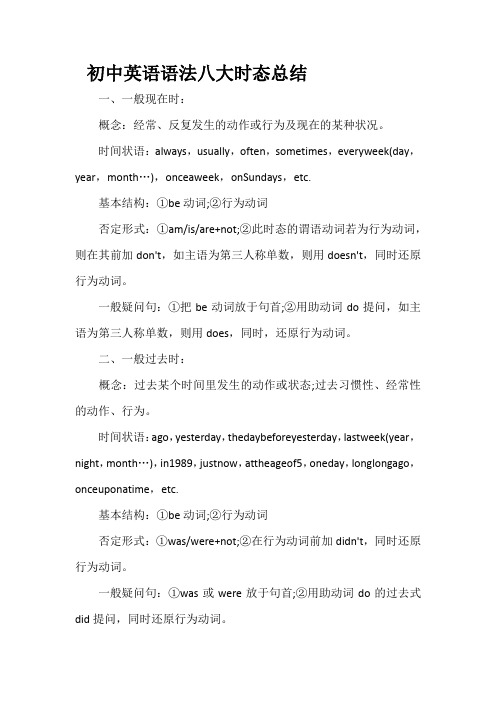
初中英语语法八大时态总结一、一般现在时:概念:经常、反复发生的动作或行为及现在的某种状况。
时间状语:always,usually,often,sometimes,everyweek(day,year,month…),onceaweek,onSundays,etc.基本结构:①be动词;②行为动词否定形式:①am/is/are+not;②此时态的谓语动词若为行为动词,则在其前加don't,如主语为第三人称单数,则用doesn't,同时还原行为动词。
一般疑问句:①把be动词放于句首;②用助动词do提问,如主语为第三人称单数,则用does,同时,还原行为动词。
二、一般过去时:概念:过去某个时间里发生的动作或状态;过去习惯性、经常性的动作、行为。
时间状语:ago,yesterday,thedaybeforeyesterday,lastweek(year,night,month…),in1989,justnow,attheageof5,oneday,longlongago,onceuponatime,etc.基本结构:①be动词;②行为动词否定形式:①was/were+not;②在行为动词前加didn't,同时还原行为动词。
一般疑问句:①was或were放于句首;②用助动词do的过去式did提问,同时还原行为动词。
三、现在进行时:概念:表示现阶段或说话时正在进行的动作及行为。
时间状语:now,atthistime,thesedays,etc.基本结构:am/is/are+doing否定形式:am/is/are+not+doing.一般疑问句:把be动词放于句首。
四、过去进行时:概念:表示过去某段时间或某一时刻正在发生或进行的行为或动作。
时间状语:atthistimeyesterday,atthattime或以when引导的谓语动词是一般过去时的时间状语等。
基本结构:was/were+doing否定形式:was/were+not+doing.一般疑问句:把was或were放于句首。
初中英语语法八大时态总结
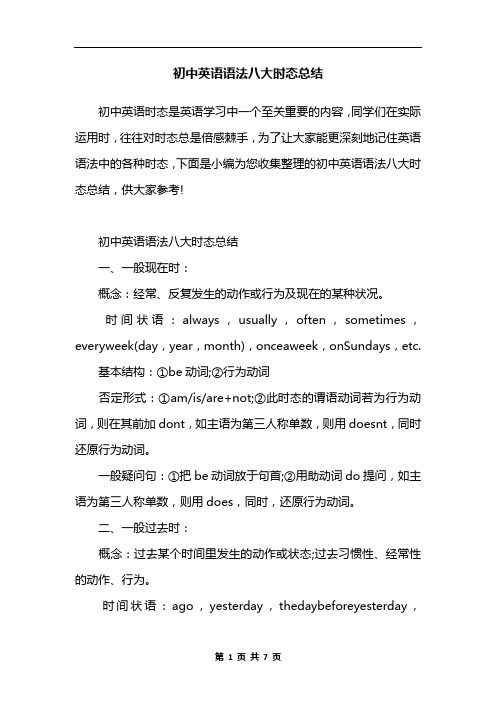
初中英语语法八大时态总结初中英语时态是英语学习中一个至关重要的内容,同学们在实际运用时,往往对时态总是倍感棘手,为了让大家能更深刻地记住英语语法中的各种时态,下面是小编为您收集整理的初中英语语法八大时态总结,供大家参考!初中英语语法八大时态总结一、一般现在时:概念:经常、反复发生的动作或行为及现在的某种状况。
时间状语:always,usually,often,sometimes,everyweek(day,year,month),onceaweek,onSundays,etc.基本结构:①be动词;②行为动词否定形式:①am/is/are+not;②此时态的谓语动词若为行为动词,则在其前加dont,如主语为第三人称单数,则用doesnt,同时还原行为动词。
一般疑问句:①把be动词放于句首;②用助动词do提问,如主语为第三人称单数,则用does,同时,还原行为动词。
二、一般过去时:概念:过去某个时间里发生的动作或状态;过去习惯性、经常性的动作、行为。
时间状语:ago,yesterday,thedaybeforeyesterday,lastweek(year,night,month),in1989,justnow,attheageof5,oneday,longlongago,onceuponatime,etc.基本结构:①be动词;②行为动词否定形式:①was/were+not;②在行为动词前加didnt,同时还原行为动词。
一般疑问句:①was或were放于句首;②用助动词do的过去式did提问,同时还原行为动词。
三、现在进行时:概念:表示现阶段或说话时正在进行的动作及行为。
时间状语:now,atthistime,thesedays,etc.基本结构:am/is/are+doing否定形式:am/is/are+not+doing.一般疑问句:把be动词放于句首。
四、过去进行时:概念:表示过去某段时间或某一时刻正在发生或进行的行为或动作。
初中英语语法八大时态总结(完整版)
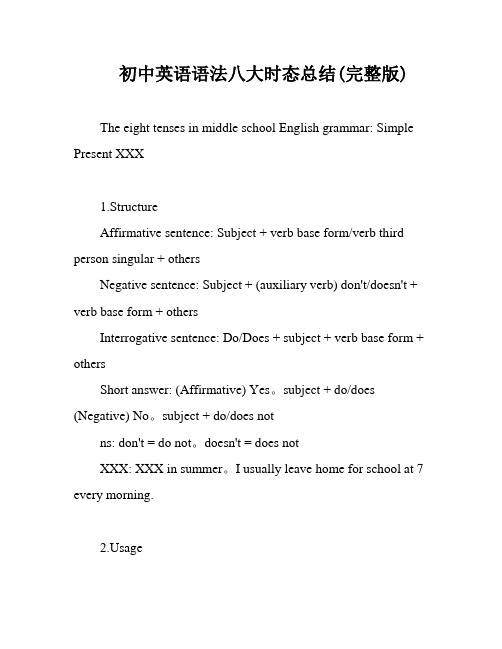
初中英语语法八大时态总结(完整版)The eight tenses in middle school English grammar: Simple Present XXX1.StructureAffirmative sentence: Subject + verb base form/verb third person singular + othersNegative sentence: Subject + (auxiliary verb) don't/doesn't + verb base form + othersInterrogative sentence: Do/Does + subject + verb base form + othersShort answer: (Affirmative) Yes。
subject + do/does (Negative) No。
subject + do/does notns: don't = do not。
doesn't = does notXXX: XXX in summer。
I usually leave home for school at 7 every morning.age1) It is used to express XXX existence。
often used with adverbs that indicate frequency。
Common frequency adverbs include: always。
often。
usually。
seldom。
never。
sometimes。
every week (day。
year。
month…)。
once a week。
on Sundays。
Frequency adverbs are usually placed before the n verb。
初中八大时态总结
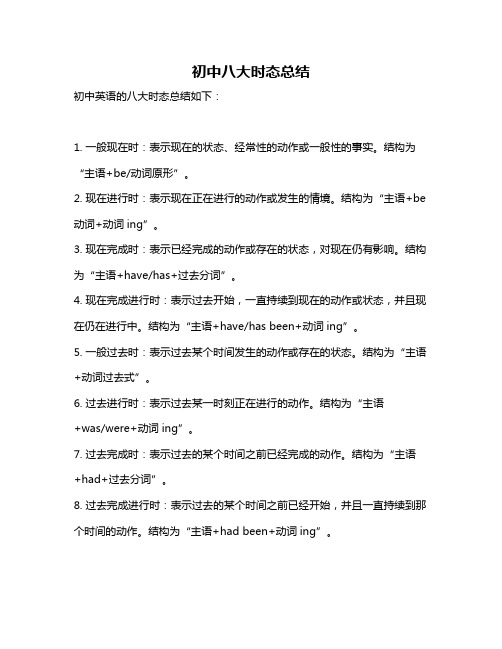
初中八大时态总结
初中英语的八大时态总结如下:
1. 一般现在时:表示现在的状态、经常性的动作或一般性的事实。
结构为“主语+be/动词原形”。
2. 现在进行时:表示现在正在进行的动作或发生的情境。
结构为“主语+be 动词+动词ing”。
3. 现在完成时:表示已经完成的动作或存在的状态,对现在仍有影响。
结构为“主语+have/has+过去分词”。
4. 现在完成进行时:表示过去开始,一直持续到现在的动作或状态,并且现在仍在进行中。
结构为“主语+have/has been+动词ing”。
5. 一般过去时:表示过去某个时间发生的动作或存在的状态。
结构为“主语+动词过去式”。
6. 过去进行时:表示过去某一时刻正在进行的动作。
结构为“主语
+was/were+动词ing”。
7. 过去完成时:表示过去的某个时间之前已经完成的动作。
结构为“主语+had+过去分词”。
8. 过去完成进行时:表示过去的某个时间之前已经开始,并且一直持续到那个时间的动作。
结构为“主语+had been+动词ing”。
以上是初中英语八大时态的总结,希望对你有所帮助。
初中英语八种时态归纳总结

初中英语八种时态归纳总结Newly compiled on November 23, 2020初中英语八种时态归纳总结时态是英语学习中一个至关重要的内容,初中学生在实际运用时,往往对时态总是倍感棘手,下面我们就归纳一下这几种时态。
一、一般现在时:概念:经常、反复发生的动作或行为及现在的某种状况。
时间状语:always, usually, often, sometimes, every week (day, year, month…), once a week, on Sundays, etc.基本结构:①主语 + be动词 + 其他;②主语 + 行为动词 + 其他否定形式:①主语 + am/is/are + not + 其他;②此时态的谓语动词若为行为动词,则在其前加don't,主语为第三人称单数,则用doesn't,同时还原行为动词。
一般疑问句:①把be动词放于句首;②用助动词do提问,如主语为第三人称单数,则用does,同时还原行为动词。
二、一般过去时:概念:过去某个时间里发生的动作或状态;过去习惯性、经常性的动作、行为。
时间状语:ago, yesterday, the day before yesterday, last week(year, night, month…), in 1989, just now, at the age of 5, one day, long long ago, once upon a time, etc.基本结构:①主语 + be动词 + 其他;②主语 + 行为动词 + 其他否定形式:①主语 + was/were + not + 其他;②在行为动词前加didn't,同时还原行为动词。
一般疑问句:①was或were放于句首;②用助动词do的过去式did 提问,同时还原行为动词。
三、现在进行时:概念:表示现阶段或说话时正在进行的动作及行为。
初中英语八大时态归纳总结
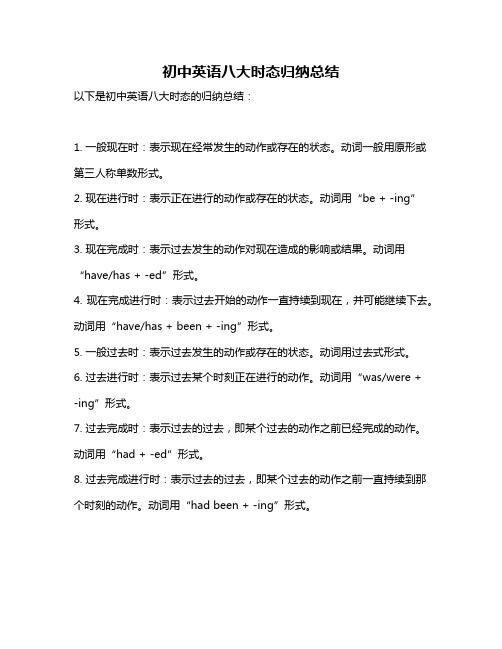
初中英语八大时态归纳总结
以下是初中英语八大时态的归纳总结:
1. 一般现在时:表示现在经常发生的动作或存在的状态。
动词一般用原形或第三人称单数形式。
2. 现在进行时:表示正在进行的动作或存在的状态。
动词用“be + -ing”
形式。
3. 现在完成时:表示过去发生的动作对现在造成的影响或结果。
动词用“have/has + -ed”形式。
4. 现在完成进行时:表示过去开始的动作一直持续到现在,并可能继续下去。
动词用“have/has + been + -ing”形式。
5. 一般过去时:表示过去发生的动作或存在的状态。
动词用过去式形式。
6. 过去进行时:表示过去某个时刻正在进行的动作。
动词用“was/were + -ing”形式。
7. 过去完成时:表示过去的过去,即某个过去的动作之前已经完成的动作。
动词用“had + -ed”形式。
8. 过去完成进行时:表示过去的过去,即某个过去的动作之前一直持续到那个时刻的动作。
动词用“had been + -ing”形式。
以上是初中英语的八大时态,理解和掌握这些时态对于英语学习和交流非常重要。
初中英语8个时态归纳总结
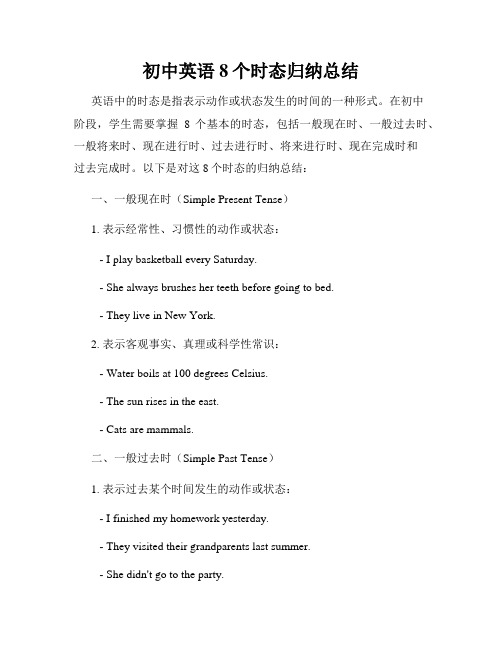
初中英语8个时态归纳总结英语中的时态是指表示动作或状态发生的时间的一种形式。
在初中阶段,学生需要掌握8个基本的时态,包括一般现在时、一般过去时、一般将来时、现在进行时、过去进行时、将来进行时、现在完成时和过去完成时。
以下是对这8个时态的归纳总结:一、一般现在时(Simple Present Tense)1. 表示经常性、习惯性的动作或状态:- I play basketball every Saturday.- She always brushes her teeth before going to bed.- They live in New York.2. 表示客观事实、真理或科学性常识:- Water boils at 100 degrees Celsius.- The sun rises in the east.- Cats are mammals.二、一般过去时(Simple Past Tense)1. 表示过去某个时间发生的动作或状态:- I finished my homework yesterday.- They visited their grandparents last summer.- She didn't go to the party.2. 表示过去的经历或习惯:- When I was young, I often went swimming. - He always ate breakfast at 8 o'clock.三、一般将来时(Simple Future Tense)1. 表示将来要发生的动作或事件:- I will go shopping tomorrow.- They are going to have a picnic next week. - She won't be late for the meeting.2. 表示将来的打算或意愿:- I am going to be a doctor when I grow up.- We will help you with your project.四、现在进行时(Present Continuous Tense)1. 表示现在正在进行的动作:- We are studying English at the moment.- He is playing soccer with his friends.- They aren't watching TV right now.2. 表示现阶段的趋势或变化:- The population is increasing rapidly.- More and more people are using smartphones.五、过去进行时(Past Continuous Tense)1. 表示过去某一时间段内正在进行的动作:- I was reading a book when the phone rang.- They were cooking dinner at 7 o'clock.2. 表示过去的同时发生的两个动作:- She was listening to music while doing her homework.六、将来进行时(Future Continuous Tense)1. 表示将来某一时间段内正在进行的动作:- Tomorrow, they will be flying to Paris.- I will be waiting for you at the station.2. 表示将来的预测或计划:- This time next month, I will be studying for my exams.七、现在完成时(Present Perfect Tense)1. 表示过去某一时间发生的动作对现在造成的影响或结果: - I have finished my homework, so I can watch TV now.- She has already eaten lunch.2. 表示过去某一时间内多次发生的动作:- We have visited that museum several times.八、过去完成时(Past Perfect Tense)1. 表示过去某一时间点之前已经完成的动作:- By the time they arrived, we had already left.- I had finished my work before the deadline.2. 表示过去的顺序或先后关系:- She realized that she had forgotten her keys after she locked the door.以上是初中英语的8个时态的归纳总结。
初中英语语法八大时态总结

初中英语语法八大时态总结学校英语语法八大时态总结学校英语时态是英语学习中一个至关重要的内容,同学们在实际运用时,往往对时态总是倍感麻烦,为了让大家能更深刻地记住英语语法中的各种时态,下面是我为您收集整理的学校英语语法八大时态总结,供大家参考!学校英语语法八大时态总结一、一般现在时:概念:常常、反复发生的动作或行为及现在的某种状况。
时间状语:always,usually,often,sometimes,everyweek(day,year,month),onceaweek,onSundays,etc.基本结构:①be动词;②行为动词否定形式:①am/is/are+not;②此时态的谓语动词若为行为动词,则在其前加dont,如主语为第三人称单数,则用doesnt,同时还原行为动词。
一般疑问句:①把be动词放于句首;②用助动词do提问,如主语为第三人称单数,则用does,同时,还原行为动词。
二、一般过去时:概念:过去某个时间里发生的动作或状态;过去习惯性、常常性的动作、行为。
时间状语:ago,yesterday,thedaybeforeyesterday,lastweek(year,night,month),in1989,justnow,attheageof5,oneday,longlongago,onceuponatime,etc.基本结构:①be动词;②行为动词否定形式:①was/were+not;②在行为动词前加didnt,同时还原行为动词。
一般疑问句:①was或were放于句首;②用助动词do的过去式did提问,同时还原行为动词。
三、现在进行时:概念:表示现阶段或说话时正在进行的动作及行为。
时间状语:now,atthistime,thesedays,etc.基本结构:am/is/are+doing否定形式:am/is/are+not+doing.一般疑问句:把be动词放于句首。
四、过去进行时:概念:表示过去某段时间或某一时刻正在发生或进行的行为或动作。
(中考英语资料)初中英语语法八大时态总结(完整版)含答案
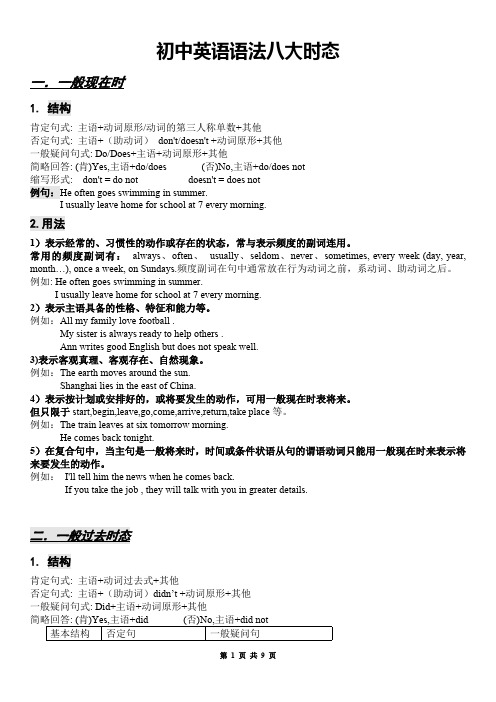
初中英语语法八大时态一.一般现在时1. 结构肯定句式: 主语+动词原形/动词的第三人称单数+其他否定句式: 主语+(助动词)don't/doesn't +动词原形+其他一般疑问句式: Do/Does+主语+动词原形+其他简略回答: (肯)Yes,主语+do/does (否)No,主语+do/does not缩写形式: don't = do not doesn't = does not例句:He often goes swimming in summer.I usually leave home for school at 7 every morning.2.用法1)表示经常的、习惯性的动作或存在的状态,常与表示频度的副词连用。
常用的频度副词有:always、often、usually、seldom、never、sometimes, every week (day, year, month…), once a week, on Sundays.频度副词在句中通常放在行为动词之前,系动词、助动词之后。
例如: He often goes swimming in summer.I usually leave home for school at 7 every morning.2)表示主语具备的性格、特征和能力等。
例如:All my family love football .My sister is always ready to help others .Ann writes good English but does not speak well.3)表示客观真理、客观存在、自然现象。
例如:The earth moves around the sun. Shanghai lies in the east of China.4)表示按计划或安排好的,或将要发生的动作,可用一般现在时表将来。
初中英语语法八大时态总结
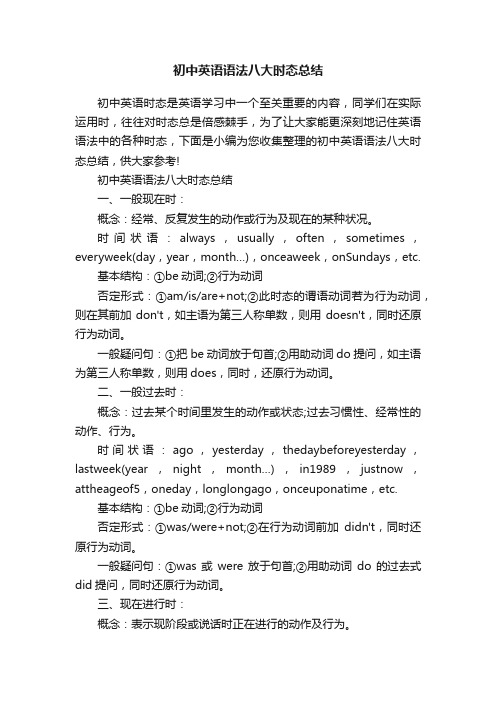
初中英语语法八大时态总结初中英语时态是英语学习中一个至关重要的内容,同学们在实际运用时,往往对时态总是倍感棘手,为了让大家能更深刻地记住英语语法中的各种时态,下面是小编为您收集整理的初中英语语法八大时态总结,供大家参考!初中英语语法八大时态总结一、一般现在时:概念:经常、反复发生的动作或行为及现在的某种状况。
时间状语:always,usually,often,sometimes,everyweek(day,year,month…),onceaweek,onSundays,etc.基本结构:①be动词;②行为动词否定形式:①am/is/are+not;②此时态的谓语动词若为行为动词,则在其前加don't,如主语为第三人称单数,则用doesn't,同时还原行为动词。
一般疑问句:①把be动词放于句首;②用助动词do提问,如主语为第三人称单数,则用does,同时,还原行为动词。
二、一般过去时:概念:过去某个时间里发生的动作或状态;过去习惯性、经常性的动作、行为。
时间状语:ago,yesterday,thedaybeforeyesterday,lastweek(year,night,month…),in1989,justnow,attheageof5,oneday,longlongago,onceuponatime,etc.基本结构:①be动词;②行为动词否定形式:①was/were+not;②在行为动词前加didn't,同时还原行为动词。
一般疑问句:①was或were放于句首;②用助动词do的过去式did提问,同时还原行为动词。
三、现在进行时:概念:表示现阶段或说话时正在进行的动作及行为。
时间状语:now,atthistime,thesedays,etc.基本结构:am/is/are+doing否定形式:am/is/are+not+doing.一般疑问句:把be动词放于句首。
四、过去进行时:概念:表示过去某段时间或某一时刻正在发生或进行的行为或动作。
初中英语语法八大时态总结
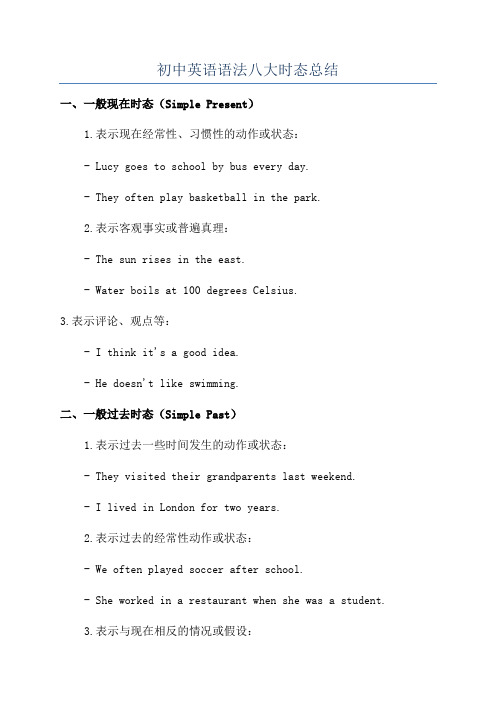
初中英语语法八大时态总结一、一般现在时态(Simple Present)1.表示现在经常性、习惯性的动作或状态:- Lucy goes to school by bus every day.- They often play basketball in the park.2.表示客观事实或普遍真理:- The sun rises in the east.- Water boils at 100 degrees Celsius.3.表示评论、观点等:- I think it's a good idea.- He doesn't like swimming.二、一般过去时态(Simple Past)1.表示过去一些时间发生的动作或状态:- They visited their grandparents last weekend.- I lived in London for two years.2.表示过去的经常性动作或状态:- We often played soccer after school.- She worked in a restaurant when she was a student.3.表示与现在相反的情况或假设:- If I had money, I would buy a new car.- I wish I could go to the concert with you.三、一般将来时态(Simple Future)1.表示将来要发生的事情:- I will meet him at the airport tomorrow.- They are going to have a party next week.2.表示意愿、打算或承诺:- I promise I will help you.- She is going to study abroad next year.四、现在进行时态(Present Continuous)1.表示现在正在进行或暂时的动作:- They are playing football in the park.- He is studying for the exam.2.表示现阶段的变化或趋势:- The population of the city is increasing rapidly.- More and more people are using smartphones.五、过去进行时态(Past Continuous)1.表示过去一些时间正在进行中的动作:- I was watching TV when she called me.- They were having dinner when the power went out.2.表示过去一些时间同时发生的两个动作:- While he was reading, his sister was playing the piano.- When I arrived, they were still waiting for you.六、将来进行时态(Future Continuous)1.表示将来一些时间正在进行的动作:- He will be sleeping when you arrive.2.表示将来一些时间同时发生的两个动作:- While you are washing the dishes, I will be cleaning the bathroom.- When I call you, she will be cooking dinner.七、现在完成时态(Present Perfect)1.表示过去发生但对现在有影响的动作或状态:- I have lost my key, so I can't open the door.- She has finished her homework, so she can watch TV now.2.表示经历或遭遇过的事情:- Have you ever been to Paris?- He has never seen such a beautiful sunset.八、过去完成时态(Past Perfect)1.表示在过去一些时间之前已经发生的动作或状态:- When I arrived, they had already left.2.表示过去一些时间之前一直存在或保持的状态:- He had lived in that house for 10 years before he moved out.- She had been planning the party for weeks.。
(完整版)初中英语八种基本时态总结

初中英语基本时态总结Ⅰ、一般现在时1、概念:1)表示经常性或习惯性的动作,常与表示频度的时间状语连用。
时间状语:always, usually, often, sometimes, seldom, never, every day, twice a week, on Sunday, etc.(提问用How often)例:I leave home for school at 7 every morning.Tom gets up at 6:00 every morning.2)客观真理,客观存在,科学事实。
例:The earth moves around the sun. 地球绕太阳转动。
Shanghai lies in the east of China. 上海位于中国东部。
3)格言或警句。
例:Pride goes before a fall. 骄者必败。
注意:宾语从句中,即使主句是过去时,从句谓语是客观真理也要用一般现在时。
例:Columbus proved that the earth is round. 哥伦布证实了地球是圆的。
2、结构:表状态S+ am/is/are+ P (句中有实义动词不用be)表动作S+V原+O (若主语是单三人称,谓动加s/es。
)3、句式变化:变疑问,有be把be提到主语前;无be在主语前加do/does,谓动变为原形。
变否定,有be在be后加“not”;无be在主语后加don’t/doesn’t,谓动变为原形。
例:①They are in the classroom. →Are they in the classroom? Yes, they are./No, they aren’t. →They aren’t in the classroom②He often waters the flowers . → Does he often water the flowers?Yes, he does. / No, he doesn’t. →He doesn’t often water the flowersⅡ、一般过去时1、概念:1)表示在确定的过去时间里所发生的动作或存在的状态。
初中英语语法八大时态总结(完整版)
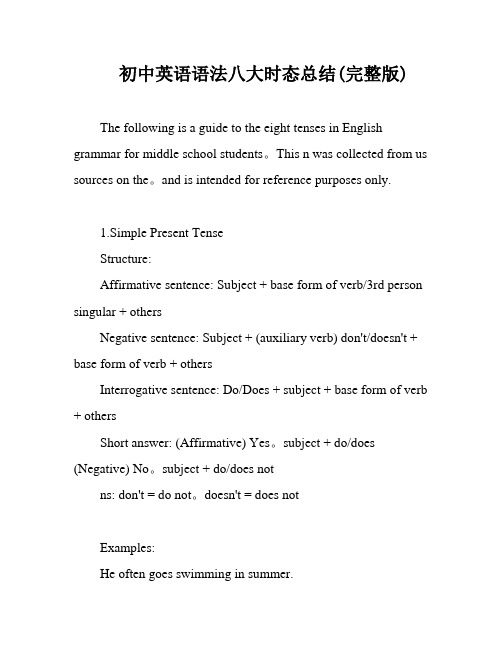
初中英语语法八大时态总结(完整版)The following is a guide to the eight tenses in English grammar for middle school students。
This n was collected from us sources on the。
and is intended for reference purposes only.1.Simple Present TenseStructure:Affirmative sentence: Subject + base form of verb/3rd person singular + othersNegative sentence: Subject + (auxiliary verb) don't/doesn't + base form of verb + othersInterrogative sentence: Do/Does + subject + base form of verb + othersShort answer: (Affirmative) Yes。
subject + do/does (Negative) No。
subject + do/does notns: don't = do not。
doesn't = does notExamples:He often goes swimming in summer.I usually leave home for school at 7 every morning.Usage:1) Used to describe habitual ns or states of being。
often used with adverbs of frequency。
Common adverbs of frequencyinclude always。
初中英语语法八大时态总结(完整版)
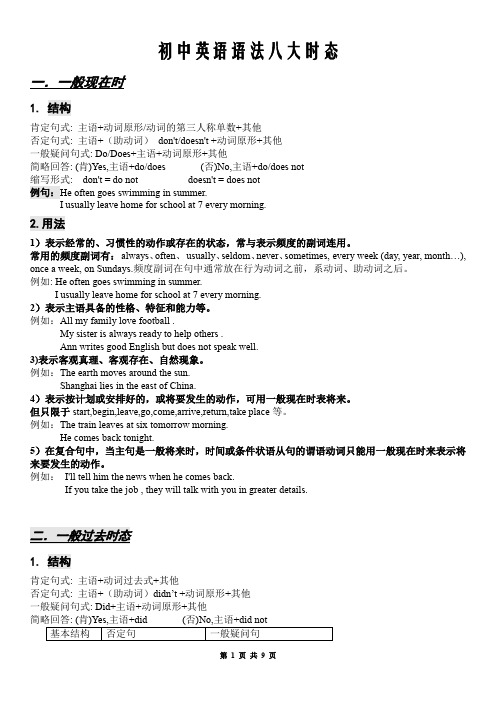
初中英语语法八大时态一.一般现在时1.结构肯定句式: 主语+动词原形/动词的第三人称单数+其他否定句式: 主语+(助动词)don't/doesn't +动词原形+其他一般疑问句式: Do/Does+主语+动词原形+其他简略回答: (肯)Yes,主语+do/does (否)No,主语+do/does not缩写形式: don't = do not doesn't = does not例句:He often goes swimming in summer.I usually leave home for school at 7 every morning.2.用法1)表示经常的、习惯性的动作或存在的状态,常与表示频度的副词连用。
常用的频度副词有:always、often、usually、seldom、never、sometimes, every week (day, year, month…), once a week, on Sundays.频度副词在句中通常放在行为动词之前,系动词、助动词之后。
例如: He often goes swimming in summer.I usually leave home for school at 7 every morning.2)表示主语具备的性格、特征和能力等。
例如:All my family love football .My sister is always ready to help others .Ann writes good English but does not speak well.3)表示客观真理、客观存在、自然现象。
例如:The earth moves around the sun.Shanghai lies in the east of China.4)表示按计划或安排好的,或将要发生的动作,可用一般现在时表将来。
初中英语八大时态总结归纳
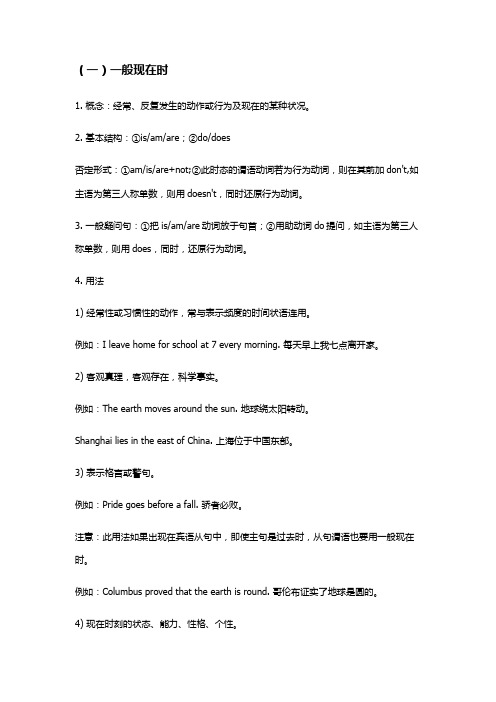
(一)一般现在时1. 概念:经常、反复发生的动作或行为及现在的某种状况。
2. 基本结构:①is/am/are;②do/does否定形式:①am/is/are+not;②此时态的谓语动词若为行为动词,则在其前加don't,如主语为第三人称单数,则用doesn't,同时还原行为动词。
3. 一般疑问句:①把is/am/are动词放于句首;②用助动词do提问,如主语为第三人称单数,则用does,同时,还原行为动词。
4. 用法1) 经常性或习惯性的动作,常与表示频度的时间状语连用。
例如:I leave home for school at 7 every morning. 每天早上我七点离开家。
2) 客观真理,客观存在,科学事实。
例如:The earth moves around the sun. 地球绕太阳转动。
Shanghai lies in the east of China. 上海位于中国东部。
3) 表示格言或警句。
例如:Pride goes before a fall. 骄者必败。
注意:此用法如果出现在宾语从句中,即使主句是过去时,从句谓语也要用一般现在时。
例如:Columbus proved that the earth is round. 哥伦布证实了地球是圆的。
4) 现在时刻的状态、能力、性格、个性。
例如:I don't want so much. 我不要那么多。
Ann writes good English but does not speak well.安英语写得不错,讲的可不行。
5) 一般现在时表示将来含义a. 下列动词come, go, arrive, leave, start, begin, return的一般现在时可以表示将来,主要用来表示在时间上已确定或安排好的事情。
例如:The train leaves at six tomorrow morning. 火车明天上午六点开。
(最新版)初中英语语法八大时态概述

(最新版)初中英语语法八大时态概述一、现在时态(Present Tense)1. 一般现在时:- 表示经常性、惯性的动作或状态:I play football every Sunday.(我每个星期天都踢足球。
)- 表示客观真理或普遍性事实:The sun rises in the east.(太阳从东方升起。
)2. 现在进行时:- 表示正在进行的动作:She is reading a book.(她正在看一本书。
)- 表示近期安排或打算:We are going to the movies tomorrow.(我们明天要去看电影。
)二、过去时态(Past Tense)1. 一般过去时:- 表示过去某个时间发生的动作或状态:He visited his grandparents last week.(他上周去看望了他的祖父母。
)2. 过去进行时:- 表示过去某一时刻正在进行的动作:I was studying when she called me.(她给我打电话的时候,我正在研究。
)三、将来时态(Future Tense)1. 一般将来时:- 表示将来某个时间将要发生的动作或状态:I will visit my friend next week.(我下周要去拜访我的朋友。
)2. 将来进行时:- 表示将来某一时刻正在进行的动作:They will be having dinner when we arrive.(当我们到达的时候,他们正在吃晚饭。
)四、现在完成时态(Present Perfect Tense)- 表示过去某个时间开始并一直延续到现在的动作或状态:I have lived here for 10 years.(我已经在这里住了10年了。
)五、过去完成时态(Past Perfect Tense)- 表示过去某个时间之前已经完成的动作或状态:She had already left when I arrived.(当我到达时,她已经离开了。
初中英语的八种时态总结_学习总结_

初中英语的八种时态总结时态是英语学习中一个至关重要的内容,广大初中学生在实际运用时,往往对时态总是倍感棘手,下面我们就归纳复习一下这几种时态。
一、一般现在时:概念:经常、反复发生的动作或行为及现在的某种状况。
时间状语:always, usually, often, sometimes, every week (day, year, month…), once a week, on Sundays, etc.基本结构:①be动词;②行为动词否定形式:①am/is/are+not;②此时态的谓语动词若为行为动词,则在其前加don't,如主语为第三人称单数,则用doesn't,同时还原行为动词。
一般疑问句:①把be动词放于句首;②用助动词do提问,如主语为第三人称单数,则用does,同时,还原行为动词。
二、一般过去时:概念:过去某个时间里发生的动作或状态;过去习惯性、经常性的动作、行为。
时间状语:ago, yesterday, the day before yesterday, last week(year, night, month…), in 1989, just now, at the age of 5, one day, long long ago, once upon a time, etc.基本结构:①be动词;②行为动词否定形式:①was/were+not;②在行为动词前加didn't,同时还原行为动词。
一般疑问句:①was或were放于句首;②用助动词do的过去式did 提问,同时还原行为动词。
三、现在进行时:概念:表示现阶段或说话时正在进行的动作及行为。
时间状语:now, at this time, these days, etc.基本结构:am/is/are+doing否定形式:am/is/are+not+doing.一般疑问句:把be动词放于句首。
四、过去进行时:概念:表示过去某段时间或某一时刻正在发生或进行的行为或动作。
初中英语语法八大时态总结

1.一般现在时2 .一般过去时3 .一般将来时4 .现在进行时5 .过去进行时6 .现在完成时7 .过去完成时8 .过去将来时1.一般现在时1.一般现在时的构成一般现在时主要用动词原形表示,如果主语是第三人称单数则动词也要用第三人称单数形式。
动词第三人称单数的构成方式如下:构成方法例词一般在词尾加-s work—works;spend—spends在以s,z,ch,sh,x等字母结尾的动词之后加-es pass—passes;wash—washes;teach—teaches;mix—mixes以不发音的e结尾的动词只在e后加-s write—writes;ride—rides 以“辅音字母+y”结尾的动词,变y为i,再加-esstudy—studies;try—tries 以o结尾的动词,在词尾加-es do—does;go—goes2.一般现在时的用法(1)表示经常性或习惯性的动作或存在的状态,常与often,always,usually,sometimes,once a week,every day/...等表示频率的副词或时间状语连用。
如:I often go to school by bike.我经常骑车去上学。
(2)表示客观事实或普遍真理。
如:The earth goes around the sun.地球绕着太阳转。
(3)在时间、条件等状语从句中,用一般现在时表示将来。
如:If it rains tomorrow,we won't go to the park.如果明天下雨,我们将不去公园。
When I grow up,I will go to America.当我长大后,我将去美国。
即学即练( )1.If Nancy ________ the exam ,she will go to Australia for English study.A .passB .passedC .passesD .will pass ( )2.The Greens will visit Hainan as soon as they ________ to China.A .comesB .comeC .cameD .will come ( )3.Now my father ________ his bike to work every day instead of driv ing.A .rideB .rodeC .ridesD .will rideC B C2.一般过去时1.一般过去时的构成一般过去时用动词的过去式表示,即:主语+动词的过去式。
- 1、下载文档前请自行甄别文档内容的完整性,平台不提供额外的编辑、内容补充、找答案等附加服务。
- 2、"仅部分预览"的文档,不可在线预览部分如存在完整性等问题,可反馈申请退款(可完整预览的文档不适用该条件!)。
- 3、如文档侵犯您的权益,请联系客服反馈,我们会尽快为您处理(人工客服工作时间:9:00-18:30)。
初中英语语法八大时态一.一般现在时1. 结构+其他单数肯定句式: 主语+动词原形/动词的第三人称否定句式: 主语+(助动词)don't/doesn't +动词原形+其他一般疑问句式: Do/Does+主语+动词原形+其他: (肯)Yes,主语+do/does (否)No,主语+do/does not简略回答缩写形式: don't = do not doesn't = does not例句:He often goes swimming in summer.I usually leave home for school at 7 every morning.2. 用法1)表示经常的、习惯性的动作或存在的状态,常与表示频度的副词连用。
:always、often、usually、seldom、never、sometimes, every week (day, year, month ⋯), 常用的频度副词有once a week, on Sundays频. 度副词在句中通常放在行为动词之前,系动词、助动词之后。
例如: He often goes swimming in summer.I usually leave home for school at 7 every morning.2)表示主语具备的性格、特征和能力等。
例如:All my family love football .My sister is always ready to help others .Ann writes good English but does not speak well.3)表示客观真理、客观存在、自然现象。
例如:The earth moves around the sun.Shanghai lies in the east of China.4)表示按计划或安排好的,或将要发生的动作,可用一般现在时表将来。
但只限于start,begin,leave,go,come,arrive,return,take plac等e。
例如:The train leaves at six tomorrow morning.He comes back tonight.5)在复合句中,当主句是一般将来时,时间或条件状语从句的谓语动词只能用一般现在时来表示将来要发生的动作。
例如:I'll tell him the news when he comes back.If you take the job , they will talk with you in greater details.时态二.一般过去1. 结构肯定句式: 主语+动词过去式+其他形+其他否定句式: 主语+(助动词)didn ’t动+词原形+其他简略回答: (肯)Yes,一般疑问句式: Did+主语+动词原主语+did (否)No,主语+did not否定句一般疑问句基本结构Be 动词was/were+not was/were提前,放于句首)行为动词didn’t+do(动词原形)Did+主语+do(动词原形3. 用法1)表示过去某一时刻或某一段时间里所发生的动作或情况。
常和表示过去的时间状语yesterday, just now, the other day, in 1982, ago, an hour ago, long long ago, the day before yesterday, last week(year, night, month ⋯), at the age of 5, one day, once upon a等t连i m用e例如:Where did you go just now?After a few years, she started to play the piano.2)表示在过去,经常或反复发生的动作。
常与often,always等表示频度的副词连用。
例如:When I was a child, I often played football in the street.我是个孩子的时候,常在马路上踢足球。
3)一般过去式也可与today,this week,this month,this year等表现在的时间状语连用,但这些时间状含“现在”“此时此刻”的意思。
语须指过去的时间,决不包?例如:Did you see him today?今天你看见他了吗三.一般将来时2. 结构1:结构肯定句式:主语+助动词will+ 动词原形+其他+not+其他一否定句式:主语+助动词will+ 动词原形+其他般疑问句式:助动词Will+ 主语+动词原形简单回答:在口语中,will 在名词或代词后常缩为won’。
t为’,ll wii not 常简缩时(I 和we)时,常用助动词shall。
在疑问句中,主语为第一人称例如:She’ll go to play basketball.Shall we go to the zoo?2:结构+其他肯定句式:主语+be going to +动词原形+其他否定句式:主语+be not going to +动词原形+其他一般疑问句式:Be+主语+going to+动词原形简略回答:(肯)Yes,主语+be (否)No,主语+be not3. 用法1)表示将来某个时间要发生的动作或存在的状态,常与tomorrow, next day(week, month, year⋯), soon, in a few minutes, by ⋯, the day after tom等or连ro用w。
例如:I'll meet you at the school gate tomorrow morning.2)、表示说话人对于将来的看法、假设和推测,通常用于be afraid, be/feel sure, hope, know, think等后面的从句或与副词perhaps,possibly,maybe等连用。
例如:I think she ’ll go back home for supper.Maybe she’ll go to the gym.将来时其他表示法1)be going to表示将来表示说话人的打算、计划、安排或根据迹象判断必然或很可能发生的事情。
例如:What are you going to do tomorrow?The play is going to be produced next month。
注意:be going to 和will 之间的区别。
在时间上:be going to 通常表示马上要发生或相当快就要发生的事情;而will 不指明任何具体时间,可以指遥远的未来。
He is going to be better.He will be better.计划/临时:两者都表示意图时,be going to 含有预先计划、准备的意思;will 则指未经过预先思考或计划,是临时的一种决定。
—What are you going to do next Sunday?—I'm going to go fishing.—Where is the telephone book?—I'll go and get it for you.两者都用于预测时,be going to 意指有迹象表明某件事将要发生,属客观的推测;will 则意指说话人认为/相信某件事将要发生,属主观的推测。
在条件状语从句中,be going to表将来,will 表意愿。
例如:If you are going to make a journey, you'd better get ready for it as soon as possible.Miss Gao will tell you the answer if you ask her.2)“beto+动词原形”表示客观安排或受人指示而将要做某事。
例如:We are to discuss the report next Saturday.3)be about to +动词原形,意为马上做某事。
不能与tomorrow, next week等表示明确将来时的时间状语连用,多于when引导的时间状语连用。
例如:He is about to leave for Beijing.四.现在进行时4. 结构:am/is/are+动词的现在分词5. 用法:1)表示现在(指说话人说话时)正在发生或进行的动作。
常与now, right now, at this moment, at this time, these days等时间状语连用。
注:如果句首有警示性动词look、listen 等,主句的动词也与现在进行时连用。
例如:We are waiting for you now.Listen! The bird is singing in the tree.2).表示现阶段(说话前后一段时间内),一直在进行的活动。
说话时动作未必正在进行。
例如:Mr. Green is writing another novel. 他在写另一部小说。
(说话时并未在写,只处于写作的状态。
)He is thinking about this problem.这些天来他一直在考虑这个问题。
3).表示反复发生的动作或持续存在的状态,常与always, constantly, forever等词连用,往往带有说话人的主观色彩。
例如:You are always changing your mind.第 3 页共9 页4).表示尚未完成的渐变过程,这样的动词有:get, grow, become, turn, run, go, begi等n。
例如:The leaves are turning red.It's getting warmer and warmer.5)、表示移位的动词,如go,come,leave,start,arrive等,其现在进行时可表将来。
例如:I'm leaving tomorrow. 明天我要走了。
The train is arriving soon. 火车要到了。
注:不能用进行时态的动词类别举例感官类See,look,smell,hear,taste,notice,feel感觉类Love,agree,like,hate,want,fear,wish,prefer认知类Believe,think,understand,forget,remember存在类Appear,exist,lie,remain占有、从属类Have,own,contain,belong,possess,consist of短暂动作类Accept,receive,admit,decide,promise,give,finish五.现在完成时6. 结构:肯定句:主语+助动词have(has)+动词过去分词-ed否定句:主语+助动词have(has)+not(haven ’t,hasn动’词t过)+去分词-ed一般疑问句:Have(Has)+ 主语+动词过去分词-ed+?特殊疑问句:疑问词+have(has)+ 主语+动词过去分词-ed+?7. 用法含义:现在完成时用来表示现在之前已发生或完成的动作或状态,但其结果却和现在有联系, 也就是说, 动作或状态发生在过去但它的影响现在还存在。
